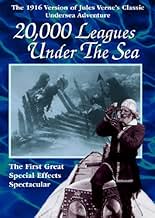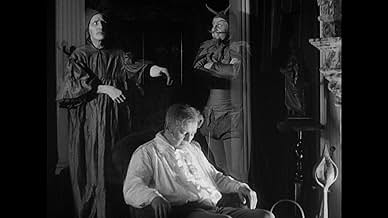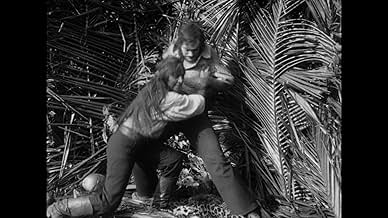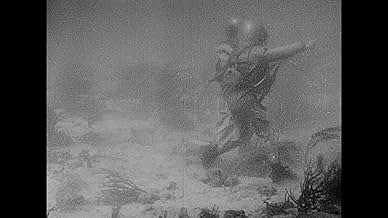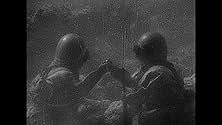PUNTUACIÓN EN IMDb
6,1/10
2,1 mil
TU PUNTUACIÓN
Añade un argumento en tu idiomaA French professor and his daughter accompany Captain Nemo on an adventure aboard a submarine.A French professor and his daughter accompany Captain Nemo on an adventure aboard a submarine.A French professor and his daughter accompany Captain Nemo on an adventure aboard a submarine.
- Premios
- 1 premio en total
William Welsh
- Charles Denver
- (as William Welch)
Wallis Clark
- Pencroft
- (as Wallace Clark)
Joseph W. Girard
- Maj. Cameron
- (sin acreditar)
Ole Jansen
- Undetermined Secondary Role
- (sin acreditar)
Noble Johnson
- Undetermined Secondary Role
- (sin acreditar)
Leviticus Jones
- Neb
- (sin acreditar)
Martin Murphy
- Herbert Brown
- (sin acreditar)
Jack Tornek
- Undetermined Secondary Role
- (sin acreditar)
Argumento
¿Sabías que...?
- CuriosidadesUnderwater cameras were not used. The Williamson brothers had developed a system of watertight tubes and mirrors, like an upside-down periscope, and were dependent on the clarity of water and sunshine to provide the necessary light.
- PifiasIn one scene on the island the balloon survivors are at a table and a black servant appears. He never shows up again and is not rescued at the end of the film with the rest of the survivors.
- Citas
Capt. Nemo: I am Captain Nemo and this is my submarine, 'Nautilus'... It has pleased me to save your lives... You are my prisoners.
- Créditos adicionalesThe opening titles announce "The First Submarine Photoplay Ever Filmed".
- Versiones alternativasKino International released a video with a music soundtrack by Alexander Rannie and Brian Benison (music © 1991). Running time is 101 minutes.
- ConexionesFeatured in Hollywood Aliens & Monsters (1997)
Reseña destacada
Underwater films are as popular today as ever in movie theaters. These motion pictures lend even the most of us landlubbers an idea how the ocean underneath the waves looks. The first feature movie to contain underwater footage is December 1916's "20,000 Leagues Under The Sea." This Jules Verne-based picture was the cinematic debut of screening submerged film footage, showing divers, a fake octopus, fish, including sharks and seabed scenery to amaze viewers back at a time when no one had ever seen under-the-ocean moving images before.
Brothers George and J. Ernest Williamson in 1914 made their experimental film, "Terrors of the Deep," also named "Thirty Leagues Under The Sea," using their newly-invented camera containing reflector mirrors running down a long tube to shoot underwater footage in the clear, relatively shallow waters of the Bahamas. An illuminating light next to the tube's lower end allowed the film to capture a moving world where no motion picture crew had been able to photograph before. The brothers promised investors who had put money into the project they would show a diver killing a shark. To make that happened, they dangled a dead horse over the side of their boat to attrack the predators. It worked.
Universal FIlm Company loved the Williamson film so much they made plans to base the underwater footage the brothers were assigned to shoot around an 1870 Jules Verne book, "20,000 Leagues Under The Sea," with director/actor Stuart Paton playing Captain Nemo. Actually, the movie was the merging of two Verne novels, "Leagues" and "The Mysterious Island."
The Williamsons returned to the Bahamas to shot scenes dictated by the script. Disney's 1954 film crew for its "20,000 Leagues Under The Sea" returned to the same spot in the Bahamas to shoot its underwater footage. The sprawling 1916 film was expensive to make in its two-year production, which included a flashback sequence towards the end employing hundreds of extras amidst elaborate India-style sets. The movie, although extremely popular, never produced a profit, discouraging Hollywood from making another Verne film for 12 years until ironically the part-talkie, two-color Technicolor MGM's "The Mysterious Island" was released in 1929.
Brothers George and J. Ernest Williamson in 1914 made their experimental film, "Terrors of the Deep," also named "Thirty Leagues Under The Sea," using their newly-invented camera containing reflector mirrors running down a long tube to shoot underwater footage in the clear, relatively shallow waters of the Bahamas. An illuminating light next to the tube's lower end allowed the film to capture a moving world where no motion picture crew had been able to photograph before. The brothers promised investors who had put money into the project they would show a diver killing a shark. To make that happened, they dangled a dead horse over the side of their boat to attrack the predators. It worked.
Universal FIlm Company loved the Williamson film so much they made plans to base the underwater footage the brothers were assigned to shoot around an 1870 Jules Verne book, "20,000 Leagues Under The Sea," with director/actor Stuart Paton playing Captain Nemo. Actually, the movie was the merging of two Verne novels, "Leagues" and "The Mysterious Island."
The Williamsons returned to the Bahamas to shot scenes dictated by the script. Disney's 1954 film crew for its "20,000 Leagues Under The Sea" returned to the same spot in the Bahamas to shoot its underwater footage. The sprawling 1916 film was expensive to make in its two-year production, which included a flashback sequence towards the end employing hundreds of extras amidst elaborate India-style sets. The movie, although extremely popular, never produced a profit, discouraging Hollywood from making another Verne film for 12 years until ironically the part-talkie, two-color Technicolor MGM's "The Mysterious Island" was released in 1929.
- springfieldrental
- 14 jul 2021
- Enlace permanente
Selecciones populares
Inicia sesión para calificar y añadir a tu lista para recibir recomendaciones personalizadas
- How long is 20,000 Leagues Under the Sea?Con tecnología de Alexa
Detalles
- Fecha de lanzamiento
- País de origen
- Idioma
- Títulos en diferentes países
- 20,000 Leagues Under the Sea
- Localizaciones del rodaje
- Empresa productora
- Ver más compañías en los créditos en IMDbPro
Taquilla
- Presupuesto
- 200.000 US$ (estimación)
- Duración1 hora 25 minutos
- Mezcla de sonido
- Relación de aspecto
- 1.33 : 1
Contribuir a esta página
Sugerir un cambio o añadir el contenido que falta

Principal laguna de datos
By what name was 20.000 Leguas de viaje submarino (1916) officially released in India in English?
Responde
